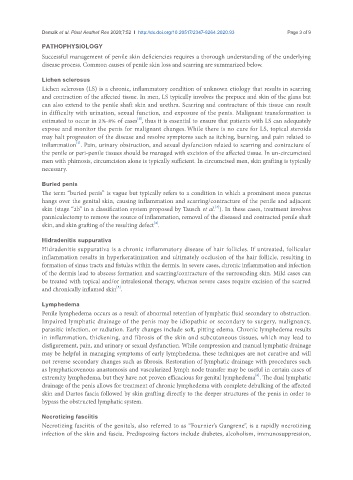Page 602 - Read Online
P. 602
Demzik et al. Plast Aesthet Res 2020;7:52 I http://dx.doi.org/10.20517/2347-9264.2020.93 Page 3 of 9
PATHOPHYSIOLOGY
Successful management of penile skin deficiencies requires a thorough understanding of the underlying
disease process. Common causes of penile skin loss and scarring are summarized below.
Lichen sclerosus
Lichen sclerosus (LS) is a chronic, inflammatory condition of unknown etiology that results in scarring
and contraction of the affected tissue. In men, LS typically involves the prepuce and skin of the glans but
can also extend to the penile shaft skin and urethra. Scarring and contracture of this tissue can result
in difficulty with urination, sexual function, and exposure of the penis. Malignant transformation is
[1]
estimated to occur in 2%-8% of cases , thus it is essential to ensure that patients with LS can adequately
expose and monitor the penis for malignant changes. While there is no cure for LS, topical steroids
may halt progression of the disease and resolve symptoms such as itching, burning, and pain related to
[2]
inflammation . Pain, urinary obstruction, and sexual dysfunction related to scarring and contracture of
the penile or peri-penile tissues should be managed with excision of the affected tissue. In un-circumcised
men with phimosis, circumcision alone is typically sufficient. In circumcised men, skin grafting is typically
necessary.
Buried penis
The term “buried penis” is vague but typically refers to a condition in which a prominent mons pannus
hangs over the genital skin, causing inflammation and scarring/contracture of the penile and adjacent
[3]
skin (stage “2b” in a classification system proposed by Tausch et al. ). In these cases, treatment involves
panniculectomy to remove the source of inflammation, removal of the diseased and contracted penile shaft
skin, and skin grafting of the resulting defect .
[4]
Hidradenitis suppurativa
Hidradenitis suppurativa is a chronic inflammatory disease of hair follicles. If untreated, follicular
inflammation results in hyperkeratinization and ultimately occlusion of the hair follicle, resulting in
formation of sinus tracts and fistulas within the dermis. In severe cases, chronic inflammation and infection
of the dermis lead to abscess formation and scarring/contracture of the surrounding skin. Mild cases can
be treated with topical and/or intralesional therapy, whereas severe cases require excision of the scarred
and chronically inflamed skin .
[5]
Lymphedema
Penile lymphedema occurs as a result of abnormal retention of lymphatic fluid secondary to obstruction.
Impaired lymphatic drainage of the penis may be idiopathic or secondary to surgery, malignancy,
parasitic infection, or radiation. Early changes include soft, pitting edema. Chronic lymphedema results
in inflammation, thickening, and fibrosis of the skin and subcutaneous tissues, which may lead to
disfigurement, pain, and urinary or sexual dysfunction. While compression and manual lymphatic drainage
may be helpful in managing symptoms of early lymphedema, these techniques are not curative and will
not reverse secondary changes such as fibrosis. Restoration of lymphatic drainage with procedures such
as lymphaticovenous anastomosis and vascularized lymph node transfer may be useful in certain cases of
[6]
extremity lymphedema, but they have not proven efficacious for genital lymphedema . The dual lymphatic
drainage of the penis allows for treatment of chronic lymphedema with complete debulking of the affected
skin and Dartos fascia followed by skin grafting directly to the deeper structures of the penis in order to
bypass the obstructed lymphatic system.
Necrotizing fasciitis
Necrotizing fasciitis of the genitals, also referred to as “Fournier’s Gangrene”, is a rapidly necrotizing
infection of the skin and fascia. Predisposing factors include diabetes, alcoholism, immunosuppression,

